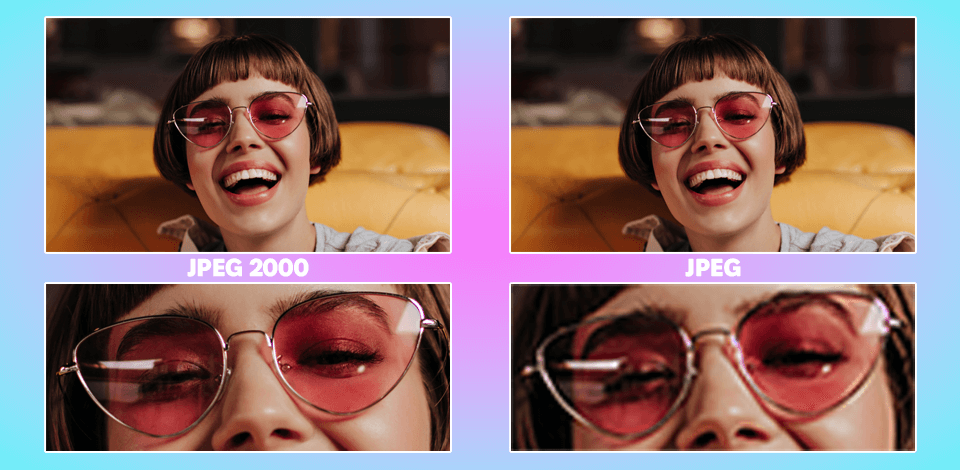
As a photographer, I always relied on the JPEG format so the “JPEG 2000 vs JPEG” debate never felt relevant to me.
However, all of that changed when one famous fashion brand ordered a large number of advertising banners from me. The photographers planned to print them out on large canvas while ensuring each detail looked clear and vibrant even when significantly enlarged.
However, after preparing the images in regular JPEG format, I noticed that their quality doesn’t satisfy my client’s requirements – they suffered from artifacts and decreased sharpness. That’s when I decided to learn more what is JPEG 2000 as a format and how it differs from regular JPEG.

✔️Lossless and lossy compression
✔️Compact file size
✔️Superior dynamic range
✔️Fantastic compression ratio
❌ Compatible with a smaller range of software
❌ Low processing speed
When pitting JPEG vs JPEG 2000, you first need to know that the latter is an improved version of the former, created in 2000 to offer superior picture quality in a smaller file. Created by the Joint Photographic Experts Group, this highest quality image format was meant to break through the limits of regular JPEG files, including artifacts and inferior quality when undergoing heavy compression.
JPEG 2000 relies on wavelet compression technology that minimizes these problems, allowing you to pick between lossless and lossy compression, which is perfect if you need to preserve the high quality of your images for large-scale prints.

✔️Perfect for the web
✔️Great quality-to-size ratio
✔️Superfast processing
✔️Compatible with most software
❌ Lossy compression
❌ Artifacting during intense compression
JPEG stands for Joint Photographic Experts Group and is probably the most widely used and most compatible image format in existence. It employs a lossy compression technology that is great at minimizing file sizes by selectively deleting parts of the image data.
As such, it’s perfect for creating web and social media content and sharing images over the internet, as all these purposes don’t require top-tier visual quality. However, the compression that JPEG files undergo can lead to artifacts and less detailed imagery, which is a huge downside when it comes to print.
The main differences between JPEG 2000 and JPEG come down to compression technology, output quality, and compatibility with different platforms and software. They can be broken down into:
Compression: JPEG employs Discrete Cosine Transform (DCT) for lossy compression, while JPEG 2000 relies on wavelet compression, which has both lossy and lossless modes.
Output Quality: JPEG 2000 offers superior picture quality, particularly at higher compression rates, preserving more detail than JPEG.
File Size: JPEG 2000 can offer the same or increased quality in a smaller file thanks to its robust compression that employs cutting-edge image optimizers, Meanwhile, JPEG may need to take up more space if you want to keep them detailed.
Support: JPEG is supported by nearly all platforms and programs, while JPEG 2000 isn’t as commonly used.
Extra Features: JPEG 2000 can display transparency and bigger bit depths, which are unachievable for JPEG.

|
|

JPEG |

JPEG 2000 |
|
Compression |
Lossy
|
Lossy & Lossless
|
|
Image Quality
|
Inferior quality at high compression
|
Superior quality at high compression
|
|
Transparency Support
|
❌ |
✔️ |
|
Color Range
|
Limited
|
Increased dynamic range
|
|
Universal Compatibility |
✔️ |
Limited
|
|
File Size
|
Bigger at higher quality
|
Smaller at higher quality
|
|
Ideal Use Cases
|
Web content, social media, online sharing
|
Pro-grade printing, digital archiving, medical images
|
JPEG 2000 provides better quality, particularly at smaller file sizes, and is capable of lossless compression. The downside is that it’s not as universally compatible as JPEG, meaning it can’t be opened in a lot of applications or uploaded to most platforms.
Even though JPEG 2000 has better quality, it won’t replace JPEG on most devices or websites since they simply don’t support the former.
Yes, various photo editing software, including Adobe Photoshop and all image converters like CopyTrans, allow you to convert JPEG and JPEG 2000 images. That said, if you convert a JPEG image to JPEG 2000 it won’t enhance its quality, as the file has already undergone compression previously.
JPEG 2000’s robust compression technology and expanded functionality demand more processing power, which is why it isn’t as widely adopted. Moreover, since it already isn’t used by most applications and devices, most new products don’t provide support for this format as well.
Employ lossless compression, as it will minimize the file size while preserving picture quality, which is exactly what you need for printing or archiving images.
If you pit JPEG 2000 vs other image formats, you’ll quickly learn that it’s not suited for web content, as it’s not compatible with most browsers and devices. JPEG is the better option due to how widely supported it is. Additionally, you can employ one of the many PDF to JPEG converters to ensure the image you want to upload is in the desired format.
Employ JPEG 2000 for cases that demand quality preservation, which usually include pro-grade and large-scale printing, medical images, and digital archives, as they value quality more than a small file size or how common the format is.